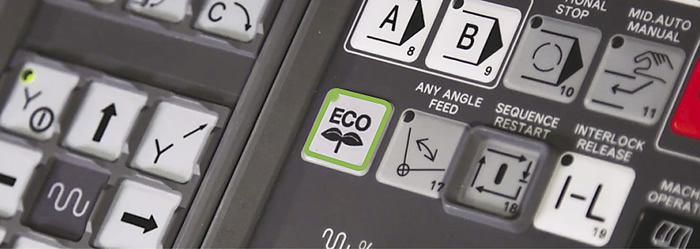Machine tool idling, unnecessary pump rotation and continuously running peripheral equipment drive up machining costs. These energy wasters are in the crosshairs of a new suite of power-cutting control applications from Japanese machine tool builder Okuma Corp.
The apps, known collectively as ECO suite, are available on Okuma machines with the OSP open-architecture CNC. Included in ECO suite is ECO Idling Stop, billed as the world’s first app able to eliminate machine tool idling. It monitors milling and turning spindles and automatically turns off spindle coolers when cooling is completed. Okuma claims the app has achieved energy savings of nearly 75 percent in noncutting operations over a 1-month period.


ECO suite apps are available on Okuma machines with the OSP open-architecture CNC. Image courtesy Okuma America.

Another part of ECO suite is the optional ECO Hydraulics. Typical hydraulic pumps lack pressure feedback and simply run at a constant speed, said Brad Klippstein, controls product specialist at Okuma America Corp. When pressure in the hydraulic system is not being used to do work, it is relieved through a pressure-regulator valve, producing a good deal of heat in the process. ECO Hydraulics provides feedback that allows it to vary pump rotational speed to regulate pressure. As a result, there is no longer any need to waste energy by relieving excess pressure through a regulator valve.
In addition, Klippstein said, the pump can be slowed when the hydraulic system isn’t doing any work. Demonstrations have reportedly shown that ECO Hydraulics can reduce pump power consumption more than 60 percent by minimizing unnecessary rotation.
A third energy-saving app—ECO Operation—lets machine operators set time limits for peripheral equipment, such as chip conveyors and mist collectors, so the equipment automatically stops after cutting is finished. A fourth app, ECO Power Monitor, shows power-consumption levels for spindles, feed axes and peripheral equipment, and lets operators see how much energy is being saved via the machine tool’s display.
Should the size of a company’s energy bill affect its level of interest in the ECO suite? “Absolutely not,” Klippstein said. “You’re still saving money with this, no matter what your energy costs are.”
For more information about Okuma America Corp., Charlotte, N.C., call (704) 588-7000 or visit www.okuma.com/americas.
Contact Details
Related Glossary Terms
- computer numerical control ( CNC)
computer numerical control ( CNC)
Microprocessor-based controller dedicated to a machine tool that permits the creation or modification of parts. Programmed numerical control activates the machine’s servos and spindle drives and controls the various machining operations. See DNC, direct numerical control; NC, numerical control.
- feed
feed
Rate of change of position of the tool as a whole, relative to the workpiece while cutting.
- gang cutting ( milling)
gang cutting ( milling)
Machining with several cutters mounted on a single arbor, generally for simultaneous cutting.
- milling
milling
Machining operation in which metal or other material is removed by applying power to a rotating cutter. In vertical milling, the cutting tool is mounted vertically on the spindle. In horizontal milling, the cutting tool is mounted horizontally, either directly on the spindle or on an arbor. Horizontal milling is further broken down into conventional milling, where the cutter rotates opposite the direction of feed, or “up” into the workpiece; and climb milling, where the cutter rotates in the direction of feed, or “down” into the workpiece. Milling operations include plane or surface milling, endmilling, facemilling, angle milling, form milling and profiling.
- turning
turning
Workpiece is held in a chuck, mounted on a face plate or secured between centers and rotated while a cutting tool, normally a single-point tool, is fed into it along its periphery or across its end or face. Takes the form of straight turning (cutting along the periphery of the workpiece); taper turning (creating a taper); step turning (turning different-size diameters on the same work); chamfering (beveling an edge or shoulder); facing (cutting on an end); turning threads (usually external but can be internal); roughing (high-volume metal removal); and finishing (final light cuts). Performed on lathes, turning centers, chucking machines, automatic screw machines and similar machines.


